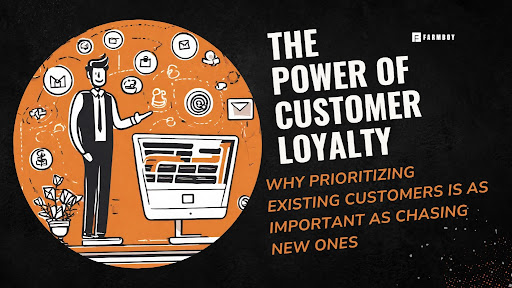In the pursuit of attracting new customers, it’s easy for businesses to forget the clients they already have. Many organizations gear their marketing strategies towards attracting fresh faces while neglecting their existing customer base. As businesses race to expand, they ignore a fundamental truth: the lifetime value of loyal customers outweighs the cost of acquiring new ones.
Existing customers are already onboard with your business. They’ve shown interest in your products or services, and they’ll likely come back for more. By treating customers right and making their experience exceptional, you gain their loyalty and trust. This makes them more likely to spread word of your business to others—it’s a win-win situation.
At Farmboy, we believe in building strong relationships with those who use our services, and urge our clients to do the same. Keep reading to learn why customer loyalty in marketing is so important.
The Value of Customer Loyalty in Marketing
It’s no secret that acquiring new customers is a pricey endeavor. From marketing expenses to sales efforts, the resources needed to convert prospects into paying customers gets spendy. Using customer retention marketing strategies is a wiser way to use your money.
Existing customers have already demonstrated their interest. Once a customer makes an initial purchase, they know what to expect from your goods or services. Happy customers stick around—if they’re satisfied by their experience, they’ll come back. Nurturing these relationships encourages consumers to come back time and time again. At Farmboy, we see this occur across many different business sectors.
Understanding Lifetime Value
The concept of lifetime value (LTV) represents the total value a consumer provides over the course of their relationship with a business. Unlike the one-time transactional value of new customers, the LTV of loyal patrons really adds up.
Using customer retention marketing strategies maximizes the value of your existing customers. These strategies aren’t just about making a sale; they’re about building relationships. You can build relationships by delivering personalized experiences, establishing excellent customer service, and implementing loyalty programs. These initiatives generate a value that exceeds the initial investment of winning the customer over. When you build a relationship with a client, they’re more inclined to make a repeat purchase, which adds to their lifetime value over time.
This outcome rings true for many of our clients, including ones selling high ticket items like custom-built homes and corporate workplace training programs. Customers are simply more likely to purchase another high ticket item from a company they trust.
The Fallacy of Neglecting Existing Customers
Many businesses fall into the trap of prioritizing new customers at the expense of keeping existing ones. Have you ever noticed how new customers receive enticing discounts and incentives, and those who have been loyal to a company seem to miss out? This approach effectively recruits new clients, but sends a message to long-term customers that their support is taken for granted. It’s not a great look—you put their trust and loyalty at stake.
Neglecting loyal customers has serious consequences. Your customers start feeling disengaged and may seek out a company more appreciative of their support.
Customer Loyalty in Marketing: Equity in Deals and Promotions
Businesses should extend perks and rewards to both new and existing customers. When businesses only offer deals and promotions to new customers, it’s unfair to existing clientele. This practice incentivizes customers to continuously seek better deals elsewhere instead of rewarding long-term loyalty.
Instead of focusing on just the new folks, spread the love to everyone by offering promotions to every client. When customer loyalty is prioritized, you build stronger connections and foster equity among consumers.
Balancing the needs of both new and existing customers can get tricky. Consider tailoring different promotions to different groups to ensure both feel valued and appreciated. For example, you can lure in fresh faces with a sweet welcome discount, and show love for your tried-and-true crew with a points-based loyalty program. Finding that sweet spot between snagging newbies and keeping longtimers happy takes some thoughtful planning, but that’s just part of the game when it comes to growing a solid business.
Customer Loyalty in Marketing: Building Stronger Relationships
Customer loyalty is the foundation for growth and success. Remember that loyalty isn’t just about repeat purchases; it’s about fostering strong connections. Focus on creating memorable experiences, personalized interactions, and meaningful engagements. Customers who feel valued and understood are more likely to become advocates for your brand, which contributes to organic growth.
Customer Loyalty in Marketing: Staying Connected
Maintaining a strong presence in front of current and past customers helps reinforce brand loyalty and engagement. Email marketing and customer relationship management (CRM) tools keep businesses in touch with their audiences. Similarly, leveraging social media platforms enables businesses to interact with customers on a more personal level, fostering a sense of community and belonging.
Asking customers to share their experience with your brand demonstrates appreciation while providing valuable insights. By inviting customers to be part of the brand story through testimonials, reviews, and user-generated content, businesses enhance brand awareness and credibility while strengthening customer relationships.
Trust us: we love getting new customers for our clients. But we also make sure we don’t overlook the immense value of their existing clientele. We recognize the true measure of success lies beyond the number of customer acquisitions, and the strength and longevity of customer relationships are what really help in the long run. Contact us today and learn how customer retention marketing strategies can propel your businesses forward!



Leave a Reply
You must be logged in to post a comment.